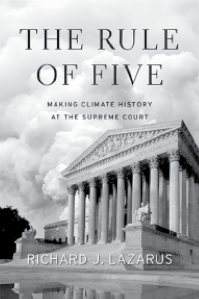The SEC Steps Toward the Full Monty on Corporate Climate Risk Disclosures

The Securities and Exchange Commission’s recent vote to propose a rule mandating that companies disclose their greenhouse gas emissions and climate change risks, if finalized, will be a big win for advocates. The Biden administration, Democratic lawmakers, environmentalists, and investors managing trillions of dollars have called for businesses to report their emissions and disclose how worsening climate change could threaten the companies’ financial health. Threats include not only direct physical damage to properties from extreme storms or rising sea levels, but also, among others, “transition risks” that could reduce the value of companies’ assets as the world moves toward increasingly common “net zero” carbon goals.
But Republicans on the Senate Banking Committee, some industry groups, and others see an effort to remake “society” or “our economy as a whole” through SEC’s disclosure standard. Clearly, the stakes are high for both sides.
With its March 21 vote approving release of a 510-page proposal that for the first time would mandate that SEC-regulated companies “provide certain climate-related information in their registration statements and annual reports,” the SEC responded to a steadily building demand for corporations to come clean on their GHG connections. At the meeting, Commissioner Allison Herren Lee noted that after she published a climate disclosure statement in 2021 while serving as acting SEC chair, the “overwhelming majority” of comments in response agreed that the commission should adopt mandatory climate disclosure requirements.
But what exactly that will mean awaits a final rule that SEC says could go into effect in December. During the 60-day public comment period, two interlinked issues will certainly be at the heart of intense discussions, as they already have been. The first issue, “materiality,” refers to whether a reasonable investor’s decisions would be affected by information disclosed, in this case about a company’s climate-related risks. The second, “Scope 3 emissions,” refers to the GHGs along a company’s value chain, such as emissions from suppliers or from a product’s use. Supply chain emissions typically account for a company’s largest carbon connection. Scope 1, a company’s direct facility emissions, and Scope 2, GHGs from purchased energy, are less controversial because they are more easily calculated.
Regarding materiality, the one commissioner who voted against the proposal, Republican Hester Peirce, protested that it would mandate climate disclosures “without regard for materiality.” Current SEC disclosure rules are “rooted in the materiality principle,” she said, and argued that the proposal would “undermine” and turn the existing framework “on its head.” GOP lawmakers have also argued that mandating disclosures of “non-material climate-related information” would undermine the concept and its central role. However, SEC Chair Gary Gensler, in voting for the proposal, stated that his decisions about climate and other disclosures are “guided by the concept of materiality.”
On the Scope 3 issue, it is worth noting SEC staff struggled with those provisions, delaying release of the draft beyond an October 2021 target date. According to Reuters, industry critics argued with SEC staff that Scope 3 GHGs should be excluded because they are beyond a company’s control and there is no consensus method for calculating those emissions.
But in discussing Scope 3 GHGs and materiality, the draft notes that disclosing those emissions might be necessary to give investors a complete picture of a company’s climate risks. The draft concedes that collecting Scope 3 data and calculating emissions “would potentially be more difficult” than for Scope 1 and 2. Yet, those emissions could be an especially significant source of “transition risks” that “may materially impact” a company’s business operations and “associated financial performance,” the proposal says.
Given the importance of Scope 3 emissions coupled with the potential data and measurement challenges, the SEC in its extensive discussion of the issue is proposing that Scope 3 disclosures only be required “if those emissions are material,” or if a business claims its GHG-reduction goal includes Scope 3 emissions, among other concessions to allay concerns. Despite obstacles, SEC included Scope 3 as a “relatively new type of metric” because “capital markets have begun to assign financial value” to the information, making it potentially “material” for investors, the draft states.
The SEC’s proposal comes after the commission published 2010 guidance that another financial regulator, the Commodity Futures Trading Commission, found did not result in high-quality disclosure of climate change risks. It also follows the UN’s latest “dire warning” about climate inaction. The time for companies to fully disclose their GHG links may have arrived at last, and with it mounting pressure to act.
The SEC Steps Toward the Full Monty on Corporate Climate Risk Disclosures


